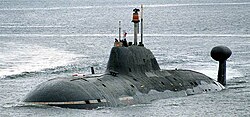Submarine

A submarine (or sub) is a vessel that goes underwater. Most large submarines are war vessels. Some small ones are used for scientific or business purposes. These are often called "submersibles" and cannot go far or stay long away from base. Some people buy their own to explore under the sea. A submarine is a boat, not a ship.
History
Early submarines were often powered by hand. This is because boat engines had not been invented yet. They were almost always made for war. Submarines would try to sink enemy ships by crude methods. These included drilling screws into their wooden hulls. Some tried to blow up a ship. This often destroyed the submarine, too. At the end of the 19th century, the Whitehead torpedo and electrical systems allowed much better submarines.
These better submarines were much used during the First and Second World Wars. Many of these better submarines were created by Germany, called U-boats. The submarines were powered by a diesel-electric system. A diesel motor would be used to turn a generator. The generator would charge a large battery while the submarine was on the surface. The power in the battery was then used by the submarine when it went underwater. These submarines were dangerous to enemies. They were difficult to see while underwater but it was easy to attack them when they surfaced to recharge. Many modern boats still use this diesel-electric propulsion system.
The First Battle of the Atlantic was the first major battle that was mainly fought between submarines and their enemies. As in later wars, the main jobs of submarines were to enforce a blockade and to sink enemy warships. They usually attacked freighters at night, shooting with their deck guns and then hiding under the water. Sometimes they used their torpedoes, which they could fire while underwater, especially against larger ships and warships. During World War II The US Navy lost around 52 submarines due to combat and non-combat causes.
After World War II better sonar helped the enemies of submarines to find and destroy them. New subs were more streamlined and had no deck guns because water dragging against the guns made noise underwater and slowed the subs.
Modern submarines
Most large modern military submarines are powered by nuclear reactors. These submarines often have a system which can get air from the seawater. These two things allow them to stay underwater for long periods of time. Their most important uses are attacking ships or launching missiles. These include cruise missiles and nuclear missiles. There are two main kinds of subs. Attack submarines are small and fast. They attack other subs and surface ships with torpedos. Missile subs are larger and slower. They are built to shoot missiles at far-away targets on land.
Submarine Media
Russian Akula-class submarine of the Northern Fleet, in 2008
- World War II fleet submarine (Gato, Balao or Tench class), commissioned 1941–1945
- The first nuclear-powered submarine USS Nautilus (SSN-571), commissioned 1954
- The ballistic missile submarine USS George Washington (SSBN-598), commissioned 1959
An early submersible craft, built by Cornelis Drebbel, propelled by oars
The French submarine Plongeur
USS Plunger, launched in 1902
Akula (launched in 1907) was the first Russian submarine able to cruise long distances.
The German submarine Template:SMU, which sank three British cruisers in less than an hour in September 1914
The Imperial Japanese Navy's I-400-class submarine, the largest submarine type of WWII
Other websites
- Submarine -Citizendium








